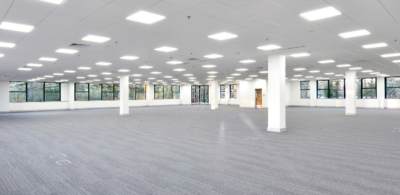The “new era” tech and creative companies—defined for our purposes as firms that have come online in the last 20 or so years, and have grown at substantial rates while subsequently expanding their office footprints—have affected arguably the two most significant components of the commercial real estate business today: the leasing of office space, and what that leased space looks like. Let’s look at the tech and creative companies that are overthrowing traditional drivers of leasing in the U.S., and how current workplace strategy trends—many of which are being driven by Tech/Creative—are influencing other sectors.
At Colliers, we’ve evaluated these trends through the lens of five key cities. If you guessed San Francisco, San Jose/Silicon Valley and Seattle, you obviously wouldn’t be wrong. But you might be surprised at just how much the new creative class has upended cities like Boston and New York, which have historically relied on more traditional industries as their office leasing stalwarts.
In Part Five of our series, we take a closer look at the San Francisco market.
Read the latest report on The Impact of “New Tech” Tenants on U.S. Office Leasing
SAN FRANCISCO
San Francisco—famously home base for some of the best-known tech companies in the world, including Twitter, Dropbox, Slack, Yelp and many others— turned in another strong quarter during the first three months of 2016, with more than 1 million square feet of leasing activity. Despite the healthy leasing volume—a slight uptick from the fourth quarter of last year—the quarter’s total actually represented a slight lagging of the 15-year historical average, although this is more a testament to how strong the market has performed during the past two years, which has inflated the quarterly average. The first quarter’s largest lease was completed by—drum roll, please— a tech company, and not just any tech company: decacorn Airbnb, with a whopping $25.5 billion valuation. The online rental titan took 150,000 square feet at 999 Brannan Street. Fellow decacorn—and current highest-valued private company in the world—Uber inked a 93,000-square-foot expansion at 1455 Market Street. Quantcast—not on the Unicorn list but one of the world’s largest data processing organizations—had the second-biggest lease of the quarter, with just under 95,000 square feet at 795 Folsom Street. And with more new-era tech/creative transactions than you can shake a server farm at, WeWork (co-working provider and New-Tech-tenant magnet) also signed on to the quarter’s top-office-leases network, taking 73,000 square feet at 600 California Street. Q2 2016 witnessed Fitbit’s lease for 306,000 square feet and Lyft’s lease/sublease of 205,000 square feet. Tech’s continued influence on the market has scaled the vacancy rate down to a near-record low, a minuscule 6.5 percent. That number is expected to shrink further after Dropbox and others take occupancy of some of their pre-leased spaces. And tech unsurprisingly accounts for just under 50 percent of current demand, with requirements totaling nearly 2.5 million square feet—all of this within view of the new tech icon transforming San Francisco’s skyline, Salesforce Tower, which when complete will stand at 1,070 feet tall.
Colliers’ clients adding to the positive net absorption include: 21Tech, Altschool PBC, Apcera, Autodesk, Beckon, Blue Shell Games, Boundary, Digital Garage, DNAnexus, Enkata Technologies, Entelo, Grow Mobile, Hypemarks, Intervision Systems Technologies, Langtech, Life360, Lob.com, PivotLink, Rabbit, RedOwl Analytics, Revitas, ServiceNow and SilkRoad Technologies.
SquareTrade—an extended warranty provider for consumer electronics that was founded in 1999 and thought to be the first online service for resolving e-commerce disputes—which moved into its current office on Third Street a few years ago, gave San Francisco both another prominent tech headquarters as well as an organization eager to stake its claim in the open-floor-plan arena. The company’s 53,000-square-foot space can house up to 500 employees and features intermediate meeting areas set up between conference rooms to enhance opportunities for spontaneous collaboration. LinkedIn recently consolidated its offices at 222 Second Street, and the new space features an entire floor dedicated to dining, a pool hall, a gymnasium, and a ground floor open to the public filled with tables and chairs. On the more traditional end of the spectrum, media heavyweight Bloomberg LP opened its West Coast Technology Hub in San Francisco last year, and the workspace features a wood liner that wraps the pantry space, an ecosystem of different types of working areas and conference rooms, and a Quiet Room designed to contrast the rest of the space. And Ernst & Young, a company that has been doing business since the mid-1800s, launched one of its first “Workplace of the Future” workspaces in its San-Francisco office, with cube-less desks alongside couches, as well as comfortable benches, cafe-style tables, and phone-booth-like micro-rooms for those who need a little privacy.
Absorption for the 2Q 2016 tallied over 268,000 square feet making a record 24th consecutive quarter of positive absorption and bringing the year-to-date total to approximately 1.06 million square feet. Tenant requirements for office space in San Francisco remains healthy with nearly 4.6 million square feet of tenant demand of which there are 12 separate requirements over 100,000 square feet for a total of over 1.8 million square feet of demand.
Coming next, part six: San Jose / Silicon Valley
Also: Read Part One: Overview | Read Part Two: New York | Read Part Three: Boston | Read Part Four: Seattle | Part Six: San Jose and Silicon Valley
As president of National Office Services for Colliers, Cynthia Foster leads our national office platform across multiple service lines, including capital markets, tenant representation, leasing agency, property management and valuation.

 Colliers Insights Team
Colliers Insights Team

 Aaron Jodka
Aaron Jodka
 Amber Merrigan
Amber Merrigan
 Andrew Steele
Andrew Steele